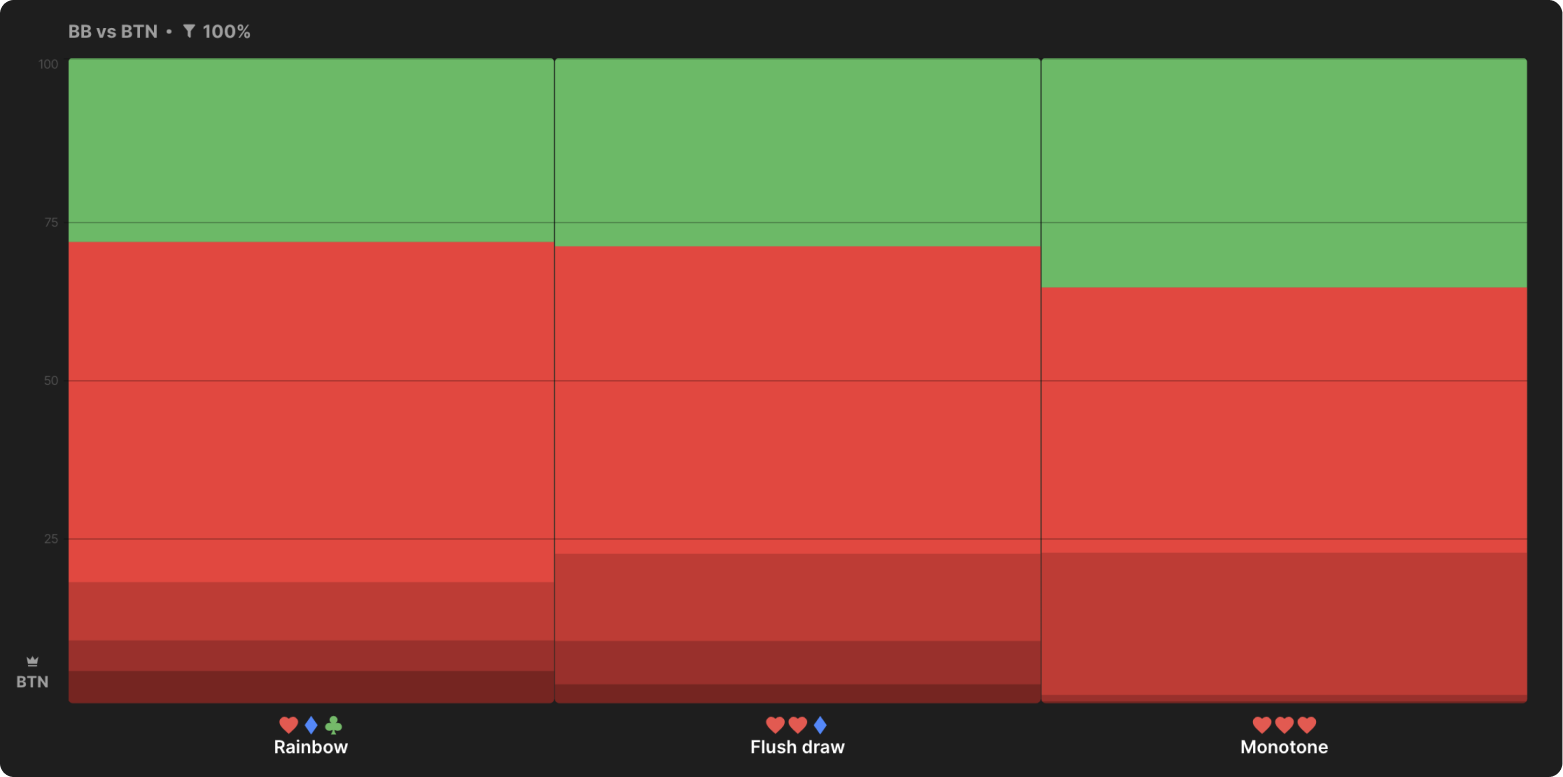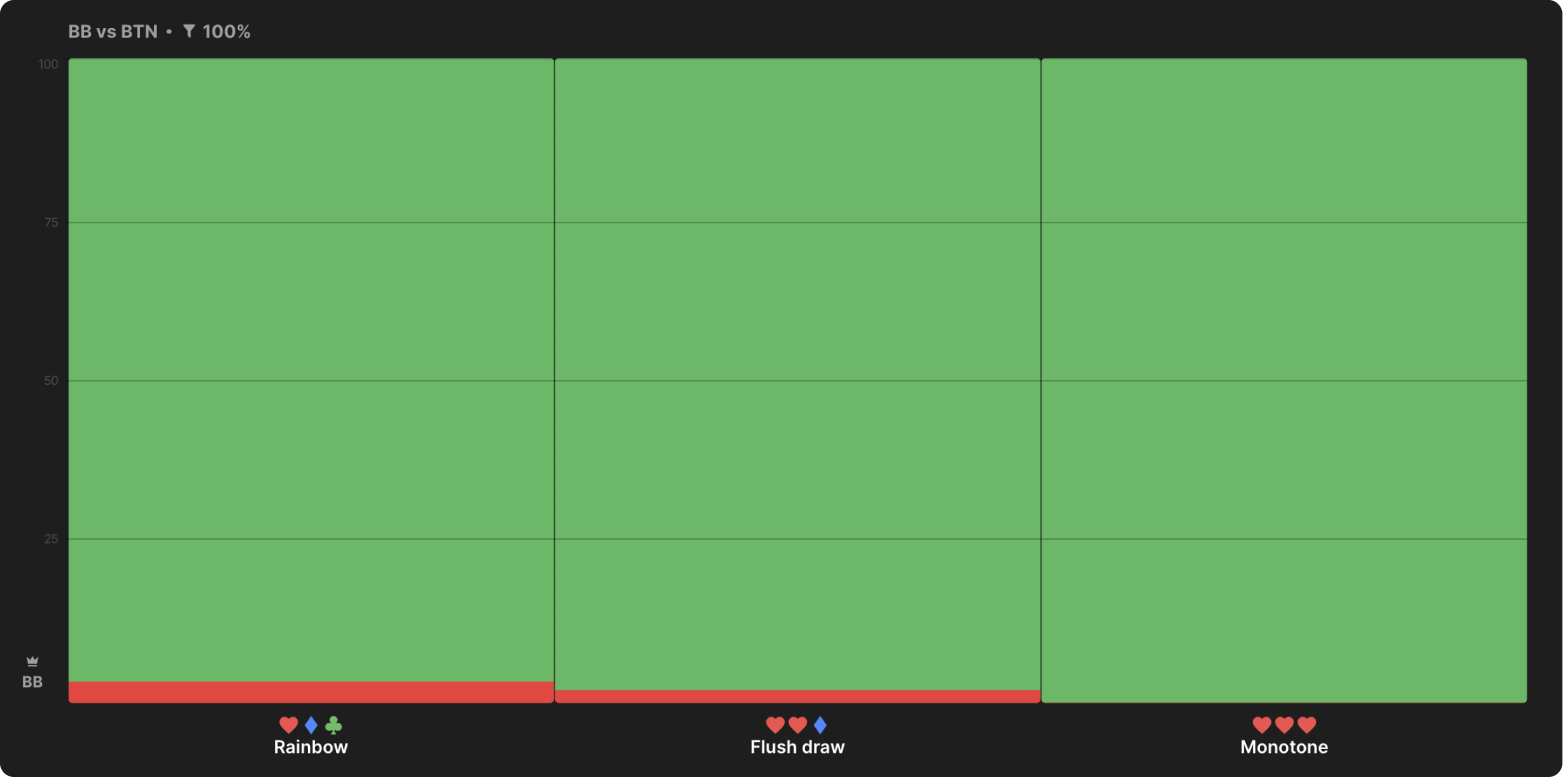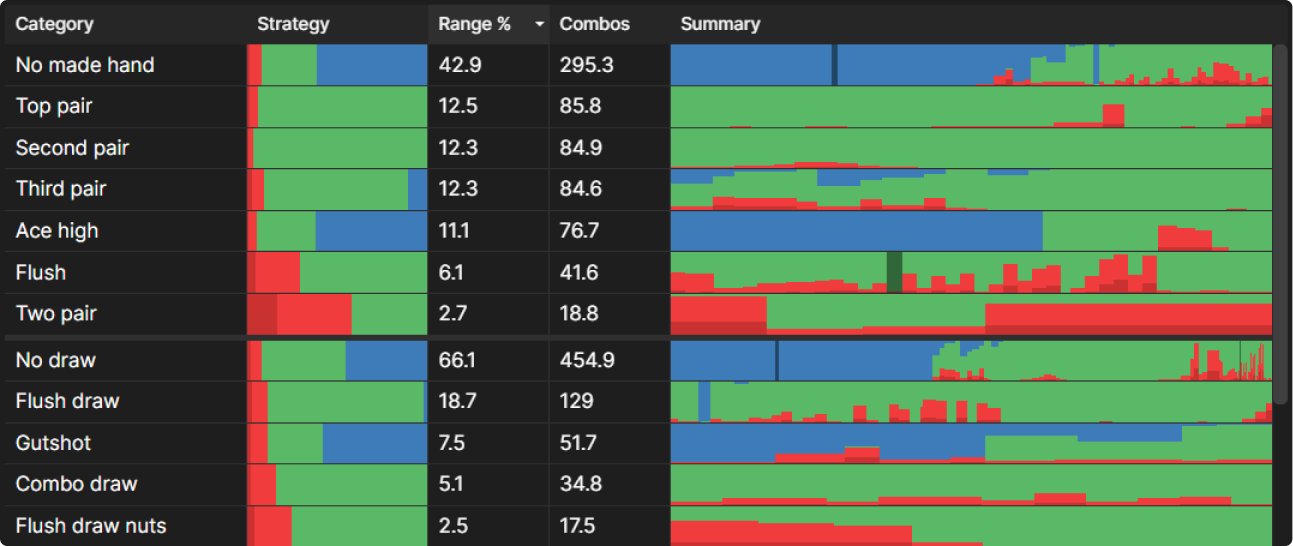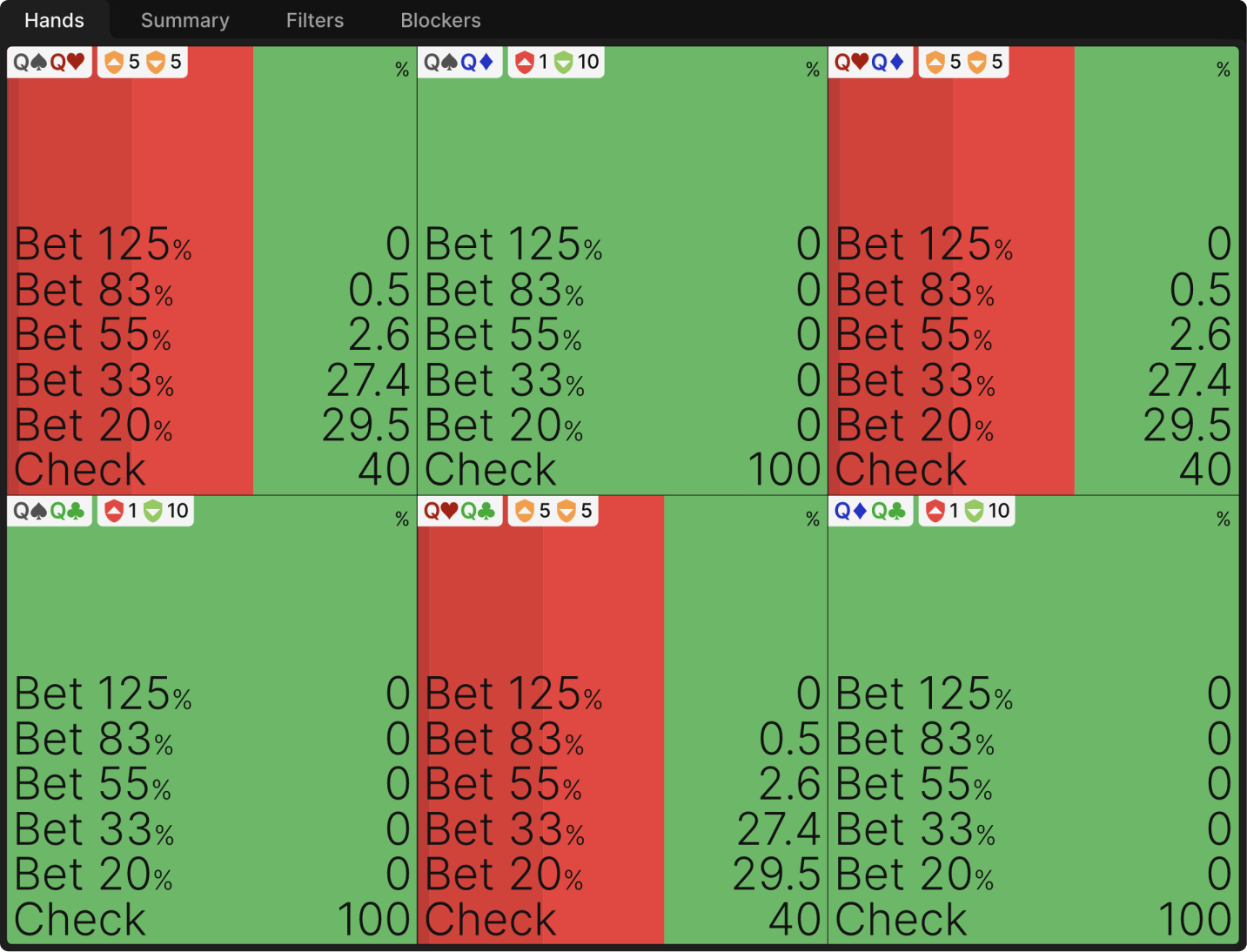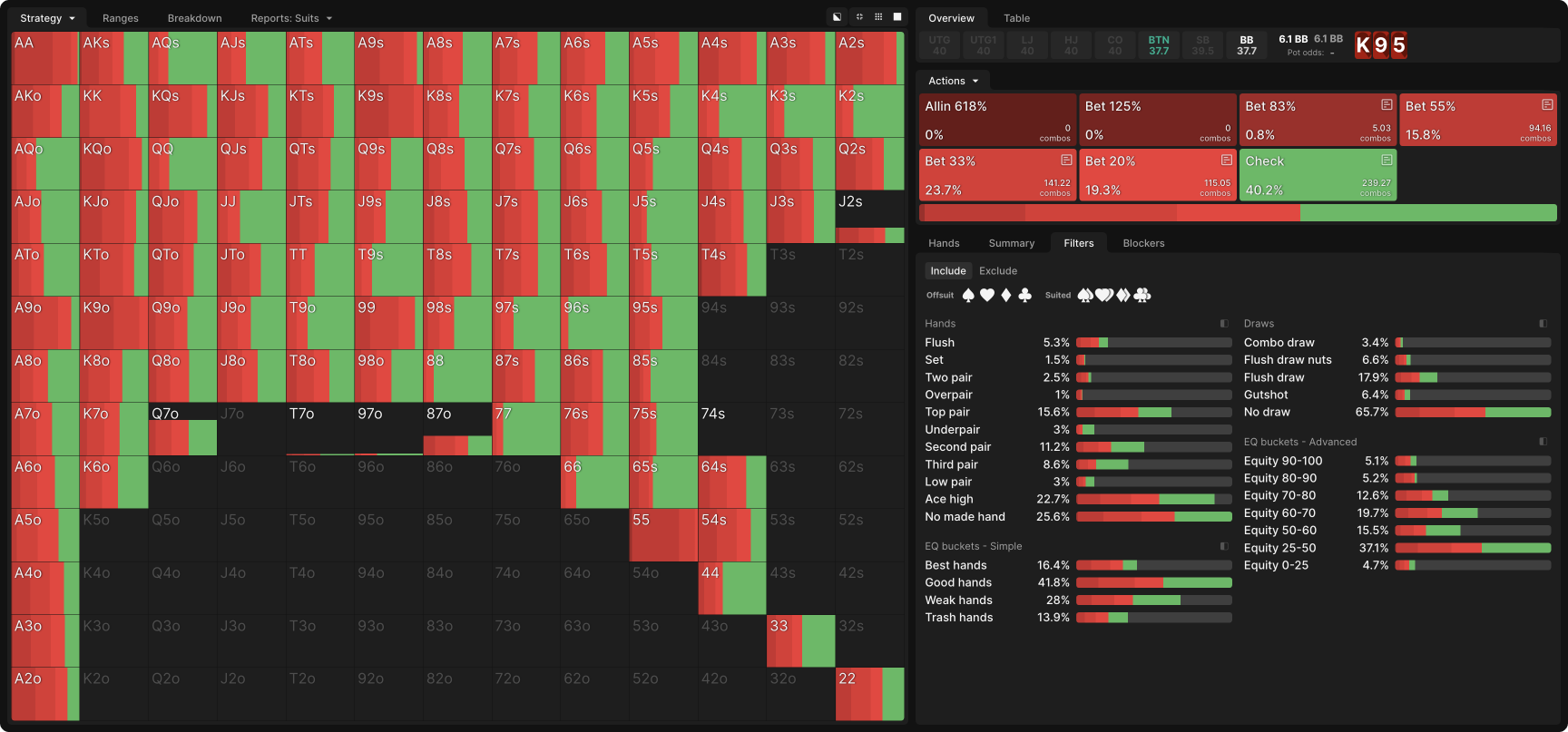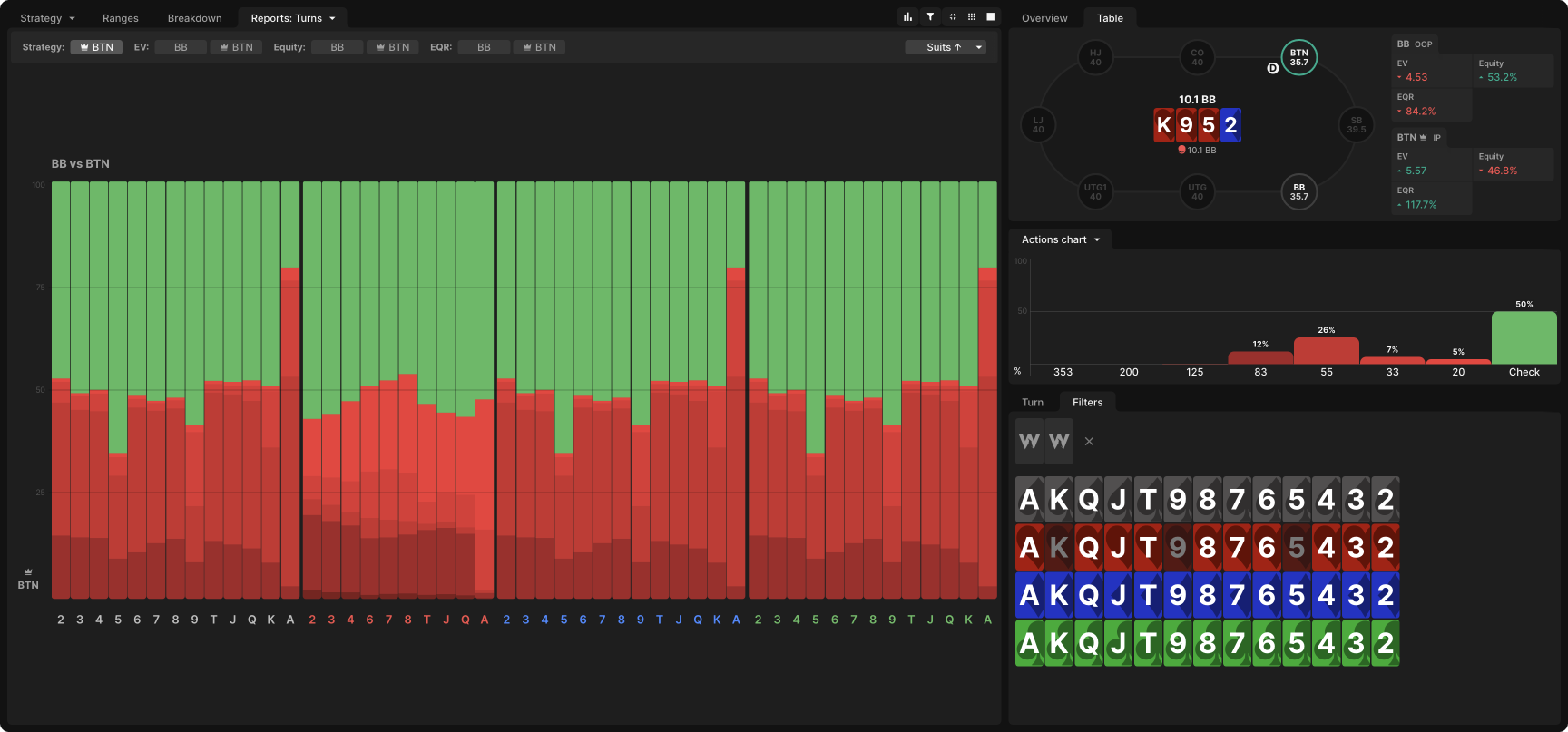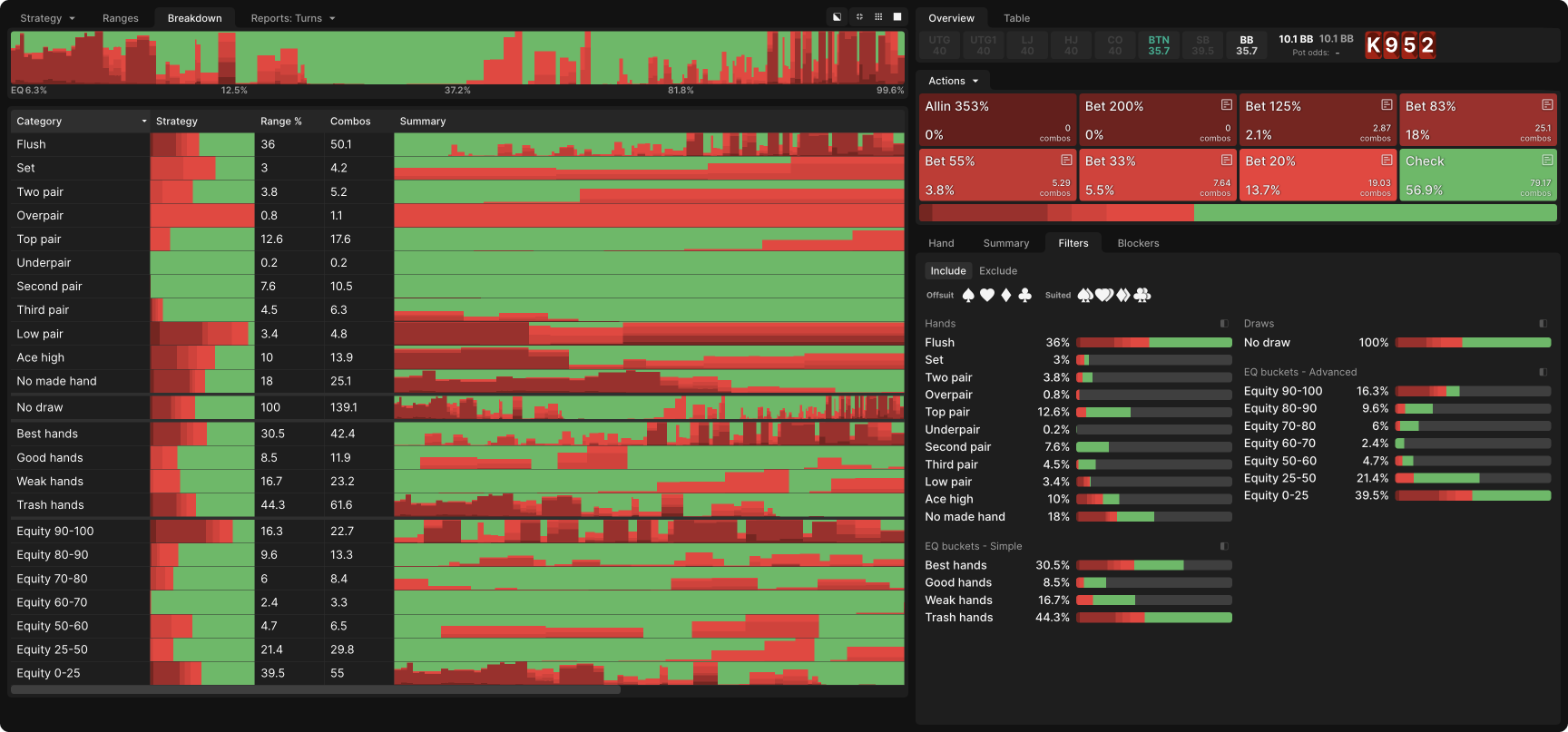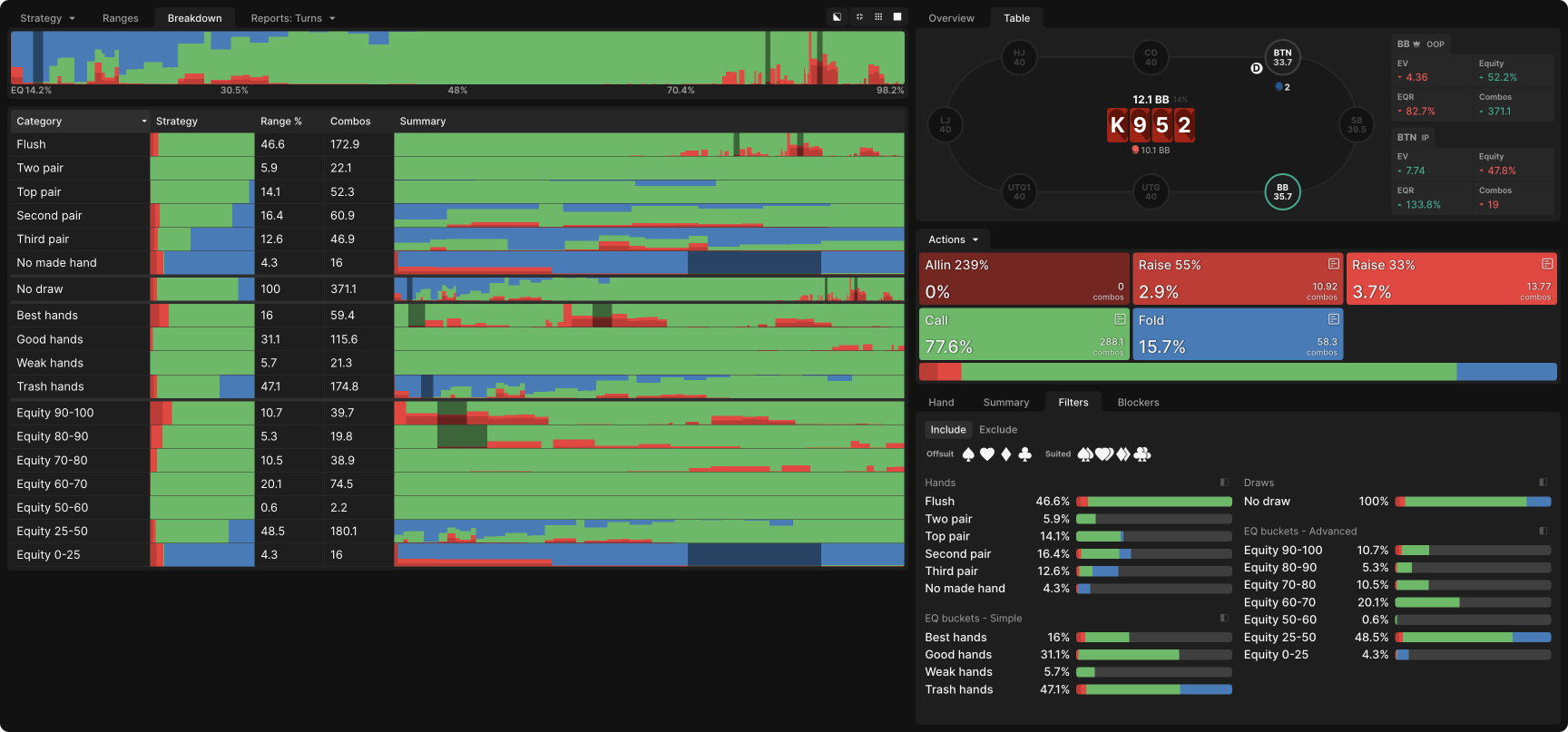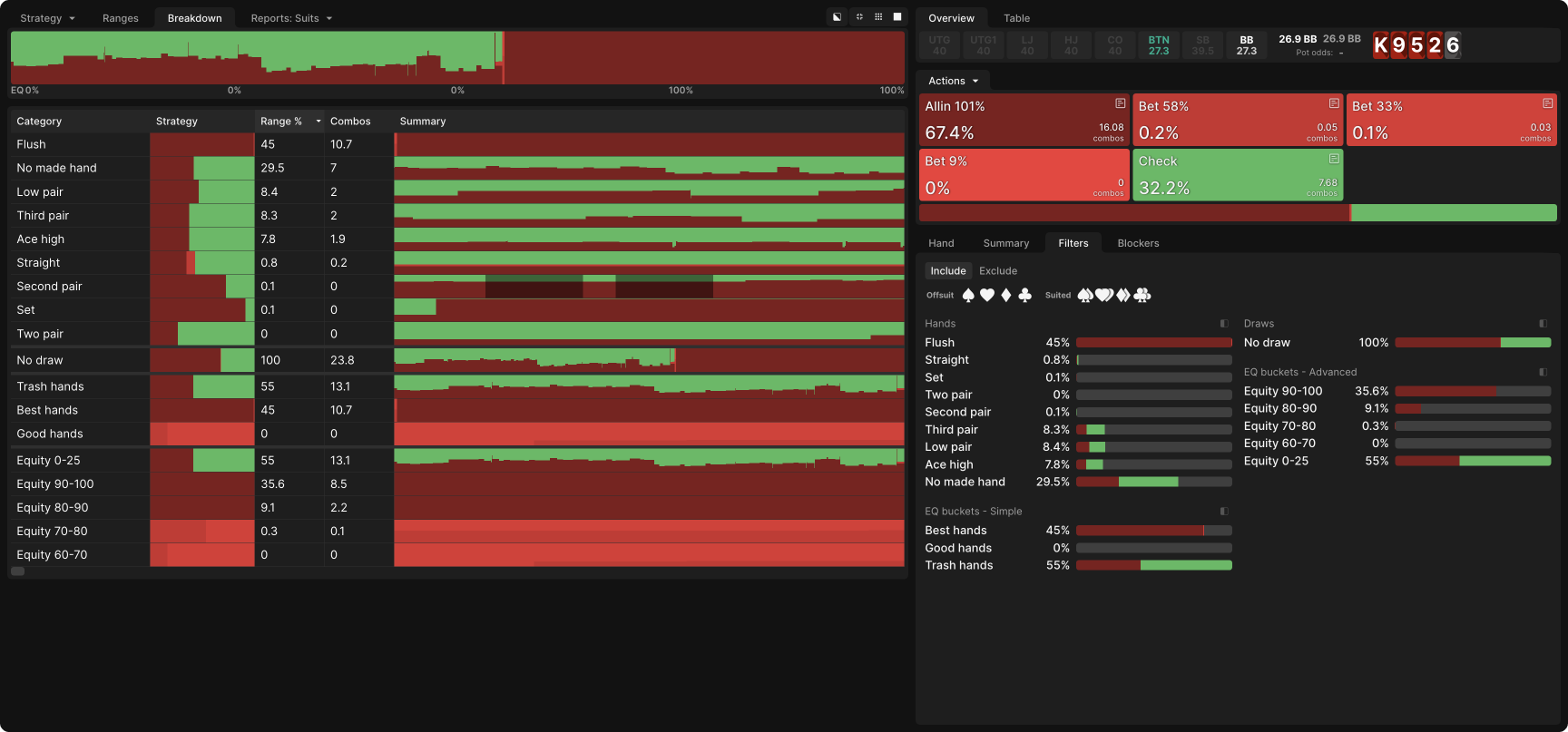Maximizing Value on Monotone Flops
MonotoneMonotone flop
All of the first 3 community cards are of the same suit. flops tend to provoke great anxiety among poker players. It’s easy to imagine that your opponent may have flopped a monsterMonster
A slang term to describe a very strong hand.. And if you have flopped a flush, it’s easy to imagine a fourth heart killing your action and devaluing your hand. Such fears, though understandable, will prevent you from playing these boards optimally if you do not learn how to conquer them. The truth is that flopped flushes are rare, and if your opponent did not flop a flush, they are not terribly likely to turn or river one either. Most of the time, they won’t even have a flush draw.
As players bet and call and the pot grows, ranges become more condensed around flush cards. Even then, however, it will generally be correct to continue playing other strong hands for value despite this risk. While we cannot consider every possible scenario in this article, we will examine several representative ones to extract strategic principles that will prove useful on any monotone flop.
Flushes Are Unlikely When the Pot Is Small
It’s hard to flop a flush. Most hands are not suited, and even when they are, they match the suit on the board less than 25% of the time (due to card removalCard removal
An effect that changes the probability distribution of cards in the deck or player’s ranges. See the Bunching effect, blockers, and unblockers. effects). In a 40bb singled-raised pot, BTN flops a flush only 5% of the time on a monotone K95 flop. BB, who plays more low suited cards, flops a flush 6% of the time.
While flush cards are strategically significant on monotone boards, they should not overwhelm other considerations.
In an UTG vs BB confrontation, both players’ preflop ranges are slightly more weighted toward suited hands. UTG flops a flush 6% of the time on K95 and BB 8%. Change that K to an A, and BB’s frequency doesn’t change much, but UTG drops to 4%; most suited hands worth playing in early position contain an Ace.
In most scenarios, a player flops a flush draw on a monotone board 25-30% of the time. This number goes down for the BB when they have called an early position open, however. On the K95 board vs UTG, they flop a flush draw only 21.6% of the time (but remember, they flop a flush more often).
Following a monotone flop, there is a roughly 20% chance the next street will bring a fourth heart (slightly higher if you hold no hearts, lower if you hold one, and much lower if you hold two).
The bottom line is that when a monotone flop is revealed, your opponent is extremely unlikely to have a flush and probably does not even have a flush draw. And even if they do flop a flush draw, they probably won’t improve to a flush. All of this is true for you as well. While flush cards are of great significance on such boards, they should not overwhelm the usual strategic considerations of pot control, thin value, and equity denial.
This all assumes a heads upHeads up
When there are only two players at a table playing against each other. pot. The more players who saw the flop, the more likely someone flopped a flush or strong draw. If multiple contestants for the pot continue putting money in on the flop, it’s virtually a certainty for at least one of them to have such a hand, and you should proceed with caution if you are not that person.
As the Pot Grows, Flush Cards Become More Important
As players bet and call and the pot grows, ranges become increasingly concentrated around the flush cards. By the time you’re contemplating shoving the river or calling a shove, they are of the utmost importance.
The following chart shows the likelihood of each player holding either a flush or a flush draw as the pot grows. It is based on a 40bb BTN vs BB single raised pot on K♥ 9♥ 5♥ 2♦ 6♣ board after BTN triple-barrels.
On the flop, flushes and flush draws are not so overwhelmingly likely as to make other strong hands irrelevant.
Monotone or not, K95 is a great flop for the BTN, and they should continuation bet at a high frequency. Thus, the 33% pot flop bet is not heavily weighted toward flushes and flush draws.
Barreling the turn, however, nearly doubles their odds of holding a flush (7% → 13% from turn to river) and makes flush draws about 20% more likely so that roughly half their turn barreling range contains at least one flush card.
By the time they shove the river, they are more likely than not to hold such a card. Of course, they will value bet all their flushes, but value betting weaker hands is also more desirable when they block flushes. Blocking flushes also makes bluffing more profitable because BB’s river calling range is also heavily centered on flush cards.
Why doesn’t BB’s range appear to condense around flushes and flush draws before the river as BTN’s does? It’s because we’re only looking at their calling range. While these hands do make good calls, they make even better raises. Flushes represent nearly 20% of their flop raising range and nearly 40% of their turn raising range.
Strategic Principles for Monotone Flops
The preflop raiser enjoys an equity advantage on most flops and prefers to capitalize on that advantage by aggressively continuation betting. We have seen that neither player is likely to flop a flush or a flush draw, but these hands become more of a concern as the pot grows. Thus, even more so than on a typical flop, the preflop raiser prefers a small size when they continuation bet. This enables them to push equity with their overall stronger range without fear of bloating the pot against flushes, which may be a larger part of BB’s range than their own range.
Let’s examine BTN’s strategy vs BB across all flops, 100bb deep:
For similar reasons, BB is especially unlikely to donk bet monotone flops, preferring to check-raise when they flop a monster:
This reinforces the point that, on the flop, flushes and flush draws are not so overwhelmingly likely as to make other strong hands irrelevant. Two pair and sets are a particularly desirable hand category to raise flop with because they are currently a strong hand that’s vulnerable to losing much of its value as more cards hit the felt. Moreover, it has the potential to become a boat and cooler your opponent’s flushes! Getting money in immediately is therefore a high priority with this kind of hand.
Low flushes may feel similarly vulnerable because it is easy to imagine a fourth heart turning to break your heart, but this is actually quite unlikely. If your two hole cardsHole cards
The two preflop cards that a player has been dealt, and only they can see, unless their hand goes to showdown. are hearts and the three community cardsCommunity cards
The face up cards shared by all players in a hand post flop. are also hearts, only eight heart cards remain in the deck, meaning a heart will turn only about 17% of the time. The risk is even lower if your opponent also holds a heart, which, if they don’t, then that fourth heart may not cost you the pot anyway (though they could still bluff you out).
As for the BTN, K♥9♥5♥ is a good flop for them, giving them more than 55% of the equity and profitable any-two-cards bluffs. They can employ a standard small-bet-at-high-frequency strategy, with a checking range centered on hands that will perform worst in a bloated pot: medium pairs without a heart.
Playing the Turn
After checking and calling a monotone flop, BB is even more inclined than usual to check the turn. This is true even on paired turns, which often incentivize donk betting:
Turning trips is less valuable on a monotone board, and after three-betting all pocket pairs preflop (at this stack depth (40bb)) and check-raising many two pairs on the flop, BB does not turn many full houses.
BTN’s barreling frequencies do not vary much between heart and non-heart turns, though of course, the composition of those ranges will change with the card:
The major exception is the A♥, which, because it features so prominently in BTN’s flop betting range, heavily blocks their flushes when it turns up on the board. Of course, it blocks many of BB’s flushes as well, but BB has a more diverse range of one-heart hands and so is less affected by any given one turning.
On a blank turn like the 2♦, BTN barrels a polar range and nearly pure checks their medium pairs, making exceptions only when they have a strong heart as a kicker. Their value region consists not only of flushes but also sets, two pairs, overpair AA, and even a fair bit of top pair. With a heart kicker, King-x is nearly a pure bet; otherwise, it’s a more even mix of bets and checks:
When bluffing, BTN is looking for some combination of overcard(s) to the 9 and a heart draw/blocker. So again, we see that while playing around the flush suit is important, it is not the only consideration. BB’s calling range contains a lot of 9-x, so having outs to a higher pair contributes some value to bluffs.
Playing Blank Rivers
On a blank river like the 6♣, BB never donk bets. BTN mostly plays a shove-or-check strategy, with any hand stronger than one pair being a pure shove. Even AK pure shoves if the Ace is a heart, which makes it less likely they will shove into a slow-played flush.
On a dry runout, it simply isn’t that likely for BB to have a flush. BTN can and should pursue full value from many weaker hands. Just how far down they can dip will depend on variables like stack depth, position, and board texture, but even when triple barreling, they do not require a flush or even a blocker to shove for value.
For bluffing, the bare A♥ is not always the best candidate because hands like AQ and AJ actually have some showdown value. A♥4x and A♥3x are better shoves, and even A♥2x shoves because the value of blocking two pair outweighs its showdown value.
BTN shoves most of their worst unpaired hands, even without a heart blocker. Higher unpaired hands like QJ are undesirable bluffs even with a heart blocker because they block more of BB’s folding range.
Two pair or better is a snap call for BB. Beyond that, top pair is not necessarily better for bluff catching than middle or bottom pair. Most pairs are indifferent, with a big heart blocker providing additional incentive to call.
Playing Blank Rivers
On a blank river like the 6♣, BB never donk bets. BTN mostly plays a shove-or-check strategy, with any hand stronger than one pair being a pure shove. Even AK pure shoves if the Ace is a heart, which makes it less likely they will shove into a slow-played flush.
On a dry runout, it simply isn’t that likely for BB to have a flush. BTN can and should pursue full value from many weaker hands. Just how far down they can dip will depend on variables like stack depth, position, and board texture, but even when triple barreling, they do not require a flush or even a blocker to shove for value.
For bluffing, the bare A♥ is not always the best candidate because hands like AQ and AJ actually have some showdown value. A♥4x and A♥3x are better shoves, and even A♥2x shoves because the value of blocking two pair outweighs its showdown value.
BTN shoves most of their worst unpaired hands, even without a heart blocker. Higher unpaired hands like QJ are undesirable bluffs even with a heart blocker because they block more of BB’s folding range.
Two pair or better is a snap call for BB. Beyond that, top pair is not necessarily better for bluff catching than middle or bottom pair. Most pairs are indifferent, with a big heart blocker providing additional incentive to call.
Playing Heart Rivers
On a 6♥ river, BB still has no donk bets, having already raised most of their strong hearts on the flop or turn. BTN still plays a mostly shove-or-check strategy. They need the J♥ (the third nuts) to shove for value. Most lower flushes check back, but with the T♥, they can consider a thinner value bet for about ⅔ pot. The main danger here is opening themselves up to a check-raise from a polarized range.
Most human players are not great at check-raising the river, so you should seriously consider this thinner value bet as an exploit against such opponents.
Blockers do not play a significant role with four hearts on the board because you can’t really block a flush without having one yourself. At this point, your hand is too strong to bluff. So, BTN mostly just bluffs their lowest-ranked hands; unpaired hands and even their smallest pocket pairs are reasonable shoves.
BB simply calls if they have a flush and folds if they don’t, making rare exceptions for hands that block especially many or few bluffs.
Playing Heart Rivers
On a 6♥ river, BB still has no donk bets, having already raised most of their strong hearts on the flop or turn. BTN still plays a mostly shove-or-check strategy. They need the J♥ (the third nuts) to shove for value. Most lower flushes check back, but with the T♥, they can consider a thinner value bet for about ⅔ pot. The main danger here is opening themselves up to a check-raise from a polarized range.
Most human players are not great at check-raising the river, so you should seriously consider this thinner value bet as an exploit against such opponents.
Blockers do not play a significant role with four hearts on the board because you can’t really block a flush without having one yourself. At this point, your hand is too strong to bluff. So, BTN mostly just bluffs their lowest-ranked hands; unpaired hands and even their smallest pocket pairs are reasonable shoves.
BB simply calls if they have a flush and folds if they don’t, making rare exceptions for hands that block especially many or few bluffs.
Playing Heart Turns
BB does not donk bet heart turns because even on the rare occasion that they have a nutty hand, taking a free card isn’t dangerous.
BTN’s strategy on the 2♥ is interesting because it entails a more polarized 83% pot betting range, a 20% pot betting range that is mostly thin value, and a checking range consisting almost exclusively of medium-strength hands:
BTN’s 20% pot bet on heart turns functions as a preemptive block bet.
The 83% pot range consists of most of their Q♥ and A♥ combos plus most of their worst hands, the same ones that bluffed the 6♥ river in the section above.
The 20% pot range consists of two pairs, sets, and even some AK and AA. It functions like a preemptive block bet, enabling BTN to squeeze a bit more value from these hands and then check back for a free showdown on the river. There are very few bluffs in this range, as the bet offers such a good price, but there are some traps in case BB decides to check-raise. The best candidates for this are hands like A♥Q♥ and Q♥J♥, which contain two big hearts and so block many of BB’s best calling hands.
Lower flushes are not in this small betting range. They check behind on the turn, intending to call river.
Facing the more polar 83% bet, BB’s response is strictly call-or-fold. Two pairs and flushes are pure calls. A bit of top pair is mixed in to hit MDF, but mostly, they fold everything less than two pair. Two pair, because of its potential to improve to a full house, is a better-than-average bluff catcher.
Against the 20% bet, they must be much more stubborn. They still don’t raise much, but they fold only their worst hands, mostly third pair and below:
Playing Rivers
BTN follows up their 83% pot bet on the turn with another polarized river bet, regardless of whether the river is a heart. On non-heart rivers, all their weak hands function about equally well as bluffs:
On a heart river, there are some pure bluffs and some pure give-ups, but the EV difference between them is slight:
Against most humans, you’ll be better off not shoving as a bluff in this scenario. These bluffs rely on BB folding not only all their chops but even some hands that beat the board, and a typical human opponent will be reluctant to make such folds.
After betting 20% pot on the turn, BTN often checks behind the river but shoves their traps and their bluffs.
However, BB actually has a robust block betting range on the river after checking and calling the smaller turn bet. On a 6♥ river, they lead 35% pot with a majority of their hands, preferring not to hold an Ace or King when they do so, as these block BTN’s folds. Because BB can often beat the board, whereas BTN’s small turn betting range was heavy on hands that now play the board (5 hearts: K♥9♥5♥ 2♥ 6♥), this bet denies BTN the cheap showdown they will often be hoping for.
On a 6♠ river, they bet smaller and less frequently. This 11% pot bet functions as a blocking bet, similar to BTN’s small turn bet, enabling BB to squeeze some thin value from low flushes and even two pair. They include the same kinds of traps: hands with two big hearts that block BTN’s value betting range.
Conclusion
Monsters are hard to come by, even on monotone boards. Bet your good hands, slow play when appropriate, and don’t give your opponents undue credit, especially not before they’ve put much money in the pot. They probably don’t have a flush, and they probably aren’t going to draw out on you. There are plenty of other hands you can get value from or push off their equity.
As the pot gets larger, flushes become more likely, and blocking them therefore also becomes more important. Even so, unless four of a suit are on the board, you should continue getting value from other strong hands and pressuring your opponent’s many non-flush holdings.
Author
Andrew Brokos
Andrew Brokos has been a professional poker player, coach, and author for over 15 years. He co-hosts the Thinking Poker Podcast and is the author of the Play Optimal Poker books, among others.





